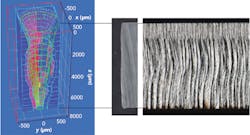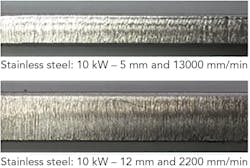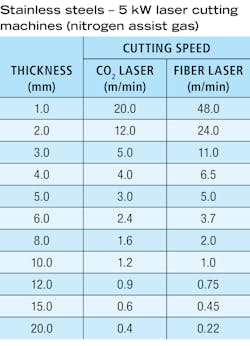The rise and rise of the fiber laser
JOHN POWELL
Way back in the mists of time, the laser cutting market was completely dominated by the carbon dioxide (CO2) laser. These had progressed from laboratory toys to industrial machines in the 1970s and 1980s, and by the 1990s, they were multikilowatt plug-and-play devices with a high level of reliability. By the turn of the millennium, the laser cutting industry was generally considered to be mature and growing steadily. No one was expecting any major steps forward in the technology by that point.
So, around 2006, I was not alone in being highly skeptical of the claims salesmen were starting to make about a revolutionary new laser cutting technology—the fiber laser.
Early results from these new lasers were interesting, but patchy—they were probably going to overtake CO2 lasers for cutting thin-section (3 mm and below) steel because they cut faster, but in thicknesses above ~5 mm, the surface quality was well below what we’d come to expect from the CO2 machines.
Experts like Dirk Petring1 got to work on why the cut quality on thicker sections was inferior and soon found the answer. In the case of CO2 lasers, the cut front was smooth and so the liquid metal flowed downwards in a very orderly way (FIGURE 1), leaving only minor ripple patterns on the cut edge.As most laser-cut stainless steel is below 6 mm thick, it is easy to see that the speed advantages of the fiber laser are commercially important. Similar (or better) improvements in productivity are also possible with non-ferrous metals and carbon steels. The only place where the fiber laser falls down is in the cutting or engraving of plastics and wood-based materials because 1 µm wavelength light passes straight through these materials.
In addition to increases in productivity, the fiber laser has other advantages over CO2 laser technology, including:
- Reduced energy consumption, as fiber lasers are more electrically efficient than CO2 machines.
- Reduced start-up time.
- Reduced physical footprint because the lasers are smaller (although the cutting tables will, of course, be the same size).
- Reduced maintenance downtime, largely because fiber lasers don’t have moving parts such as vacuum pumps and blowers, which are incorporated into CO2 machines.
In the early days, there were problems with the cost of parts that broke down on fiber lasers, including the fiber connectors and the modules of diodes that power the machines, but these have largely been dealt with as a result of improved reliability and increases in warranty periods.
Given all these advantages, it’s not surprising that fiber lasers are ruling the roost. It seems that, in the UK at least, the future of the CO2 laser will be confined to the niche market of cutting or engraving plastics and wood-based products.
REFERENCES
1. D. Petring, T. Molitor, F. Schneider, and N. Wolf, Phys. Procedia, 39, 186–196 (2012).
2. J. Powell, LIA Guide to Laser Cutting, 2nd Edition, ISBN 9780912035161 (2008).
3. J. Powell, D. Petring, J. Pocorni, and A. Kaplan, LIA Guide to High Power Laser Cutting, ISBN 9781840168111 (2017).
Dr. JOHN POWELL ([email protected]) is technical director of Laser Expertise Ltd (Nottingham, England), which he co-founded in 1984. He is the author or co-author of three books on laser cutting, the latest of which is the LIA Guide to High Power Laser Cutting.2
EDITOR’S NOTE: This article was reprinted from The Laser User, Issue 93 (Summer 2019), with permission from the author and The Association of Laser Users (AILU); ailu.org.uk.




